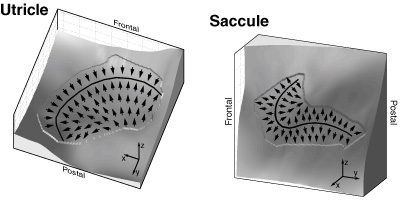
Data

The on-directions are stored in OnDirs.mat
Methods
It has been found that accelerations which are locally perpendicular to the surface of the epithelium lead to no or very small responses in the vestibular nerve (Fernandez et al., 1976). From this it may be concluded that accelerations are most effective in altering the polarization of a particular hair cell if they are in a tangent plane to the epithelium at the location of the hair cell. Since the direction on the tangent plane which leads to the largest depolarization of the cell defines the polarization vector, this vector can be constructed from basis vectors of the tangent plane: projecting an initial vector into the local tangent plane creates the polarization vector of a hair cell. Initial vectors can be obtained from publications that qualitatively depict the distributions of polarizations vectors in 2D (Flock 1964; Lindeman 1969; Fluur 1970; Rosenhall 1972). To simplify the task of setting the initial vectors, we created a graphical user interface that allowed manual control over the orientation of the 2D vectors with the mouse, and automatically projected them on the 3D epithelium. In this way, approximately 3000 and 2000 polarization vectors were used to represent the epithelia of the utricle and saccule, respectively. Every polarization vector of this sample is associated with a specific location on the epithelium. To compare them with the results of Fernandez et al., we neglected the position information and represented the normalized vectors in a Cartesian coordinate system. All vectors now start at the center of the coordinate system and end at a sphere with radius one. Because of the curved shapes of the epithelia and their distribution patterns of polarization vectors, the number of vectors that end in a small area around a point on the sphere depends on the location of the point. The curved shape further results in different sizes of the epithelia areas associated with the polarization vectors. By counting the number of vectors that end in a particular area on the unit sphere and weighting them with the size of their corresponding epithelia areas, a density distribution of polarization vectors on the unit sphere can be obtained.
Fernandez C, Goldberg JM (1976) Physiology of peripheral neurons innervating otolith organs of the squirrel monkey. II. Directional selectivity and force-response relations J Neurophysiol 39: 985-995
Flock Å (1964) Structure of the macula utriculi with special reference to directional interplay of sensory responses as revealed by morphological polarization J Cell Biol. 22: 413-431
Fluur E (1970) The interaction between the utricle and the saccule Acta Otolaryng 69: 17-24
Lindeman HH (1969) Studies on the morphology of the sensory regions of the vestibular apparatus Ergeb Anat Entwicklungsgesch 42: 1-113
Rosenhall U (1972) Vestibular macular mapping
in man Ann Otol 81: 339-351